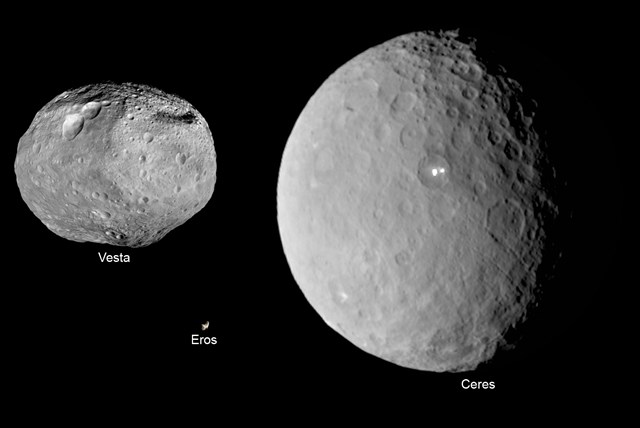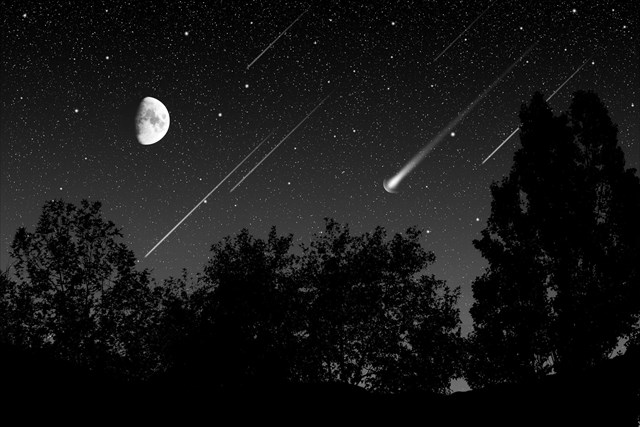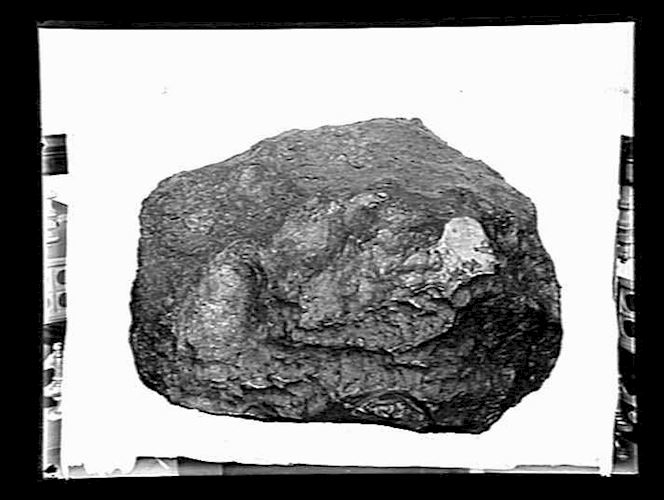
Above: The asteroids Vesta, Eros and Ceres
But first: what is a meteorite?
A meteorite is an asteroid that makes it to earth without burning up in the earth's atmosphere. An asteroid is a rocky object in space that is smaller than a planet.
Some of these pieces of 'space debris' are left over from when the solar system formed. Most of them orbit between the planets Mars and Jupiter in what is called 'the asteroid belt'. Some are huge and kilometres wide, such as Ceres, which is 940km wide and is often considered a dwarf planet.

Above: A meteor shower, or shooting stars.
But what's the difference between a meteor and a meteorite?
A meteor is an asteroid, meteoroid, micrometeoroid or comet that makes it to the earth's atmosphere but burns up before reaching earth. The flash that you see is the meteor, not the debris itself. This is also called a shooting star.
So what's a meteoroid, micrometeoroid and a comet?
Okay, a meteoroid is the debris that is left when a meteor burns up. There's usually not much left and most of it vapourises before it reaches earth.
A micrometeoroid is the tiny pieces of the meteoroid that usually weighs less than a gram and stays in space. There's also micrometeorites that, you guessed it, are tiny pieces of meteorite that make it to earth.
A comet is an asteroid-like object that has a fuzzy, cloud-like shell and you can sometimes see a visible tail whenever it orbits close to the Sun.
Okay, I hope that's clear.

Above: Cranbourne meteorite no. 2 at the Melbourne Museum.
Twelve masses of the Cranbourne meteorites have been found since 1854. They are now located in varying places around the world such as the British Museum, the U.S. National Museum in Washington, the Melbourne Museum, the Casey Council offices in Narre Warren, and here in the School of Earth Sciences at the University of Melbourne.
It is not known when the Cranbourne meteorites fell, but it could be as long ago as 2,000 years ago or as recently as 200 years ago.
Meteorite no. 1 was found by settlers when they noticed the indigeous peoples dancing around it. In 1854, meteorite no. 1 was exhibited at the Melbourne Exhibition after a farrier had made a horseshoe from a piece chiselled from it.
Meteorite no. 7 was found in 1923 by Mr A.R. Croker in Devon Meadows. It was found in the same paddock as no. 5 and no. 8 after the farmers had ploughed their paddocks. No. 7 was found in a straight line in the vicinity of no. 1, which gave researchers vital clues in the flight path of the meteorite shower.
The Cranbourne meteorites are made up of four chemical elements. Meteorite no. 7's elements are printed on a brass plaque under the display. The main composition of the meteorite is Iron (Fe) , Nickel (Ni), Cobalt (Co) and Phosphorous (P).
There are three classes of iron meteorites, and these are classified by their proportion of nickel to iron. There are Hexahedrite meteorites with about 4 per cent nickel contents, Octahedrite meteorites with 6 to 12 per cent nickel contents and Ataxite meteorites with over 20 per cent nickel contents. I'm not telling you this for fun; it is in the test.
An interesting feature of Octahedrite meteorites with this particular proportion of iron and nickel is that when they become unstable, for example, if they cool down, they form an alloy called kamacite that is only found on Earth in meteorites. This forms a distinctive pattern. If you were to get an Octahedrite meteorite and cut, polish and etch it with an acid/alcohol solution you would see that it has a pattern inside called a Widmanstatten structure. The slower the cooling rate is, the larger the grain structure of the Widmanstatten structure.
To log this EarthCache as a find, go to the School of Earth Sciences at the University of Melbourne. There's another EarthCache a few metres below called School of Rock.
1. Find Cranbourne meteorite no. 7. It is swimming in murky water. Look at its composition and the proportion of iron to nickel. How much iron and nickel is in meteorite no. 7? What class of meteorite does this make meteorite no. 7?
2. Looking at the composition of iron and nickel in meteorite no. 7, if you could cut it open, and polish and etch the surface, do you think it would have a Widmanstatten structure?
Once you complete the EarthCache requirements you can post your find without delay, as per the EarthCache guidelines. You will also need to verify your find by sending me a message and provide your answers to the questions.
Access details
Visitors can catch any tram along Swanston Street to the University of Melbourne Tram stop number 1 and walk a short distance. The number 1 or 8 trams towards Moreland and Coburg, respectively, stop directly outside the McCoy building entrance - Tram Stop 111-Elgin St/Swanston St.
The main entry doors to the McCoy building are located one level up on the 2nd Floor and are accessed via the stairs or ramp from Elgin Street or from the main Parkville campus via the bridge across Swanston Street.
Please note: this building does not have 24-hour access.
| I am a proud |
 |